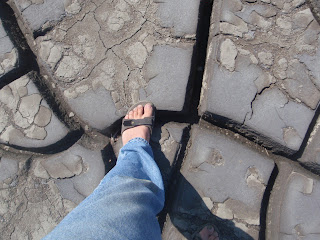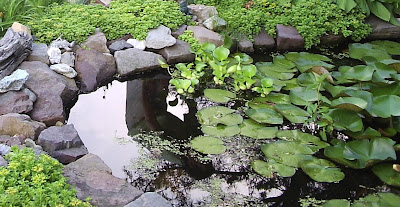This post is a mess, an amalgam of several yet-born posts swirling about.
This is a tool, made by
Takeshi Yamada, an artist who saw visions while surveying horseshoe crabs on the shores of our bay.
It is a
pen crafted from the tail of a horseshoe crab. Mr. Yamada uses it almost every day, to create stunning images.
Compared to some tools, his pen may be thought inefficient. It certainly lacks the precision of a
YAG laser engraver , or even a Koh-I-Noor 5611 drafting pencil, but that's not the point. That's not the point at all.
Mr. Yamada is human, with the same frailties as any of us, with the same natural curiosity. He did not learn to use his telson in an American school. There is no place for it there.
Unique does not guarantee better. Unique things are often unique because they are not worth reproducing. Technology thrives on precise, efficient, reproducible results. There is little room for Mr. Yamada in the industrial world.
Mr. Yamada's work, however, gives me pleasure. His work pleases others as well. Someone shared it with me, now I share it with you.
***
Gerald Aungst, "a supervisor of gifted children," writes for
Connected Principals, a shared blog written by school administrators, a blog well worth visiting. His recent post
"Why 'I Don’t Do Technology' Isn’t Acceptable" raises some good points, and I have no qualms with the thesis of its title. His arguments within the article, however, reveal some interesting thoughts shared by many technophiles, and I'd like to offer some views from the other side of the aisle, an aisle I straddle with my Google + account in my right hand, my Dixon Ticonderoga No. 2 pencil in my left.
Go read the post. I'll go check my sundial and pick weeds from my garden while you read.
***
"Some people argue that technology is simply a tool to be applied where and how it’s appropriate. Others say no technology is neutral and we have to be deliberate in our choices to use it."
The two are not mutually exclusive--"appropriate" covers a lot of ground. We also should consider what is lost when a newer technology is used. Reel mower vs. gas-powered rotary. Pencil vs. pixels. Chalkboard vs. IWB.
I'm a retired doc--before I stopped succoring the afflicted I saw the mess high tech mania produced in medicine. Mr. Aungst's example of the CT machine is an interesting example, because of the quandaries it has created, and because of the change in skills that have resulted.
Classic appendicitis (and many subtle variants) can be diagnosed by history and physical exam alone
if the practitioner has learned how to do this. CT scans are quite useful in certain situations, but are often superfluous, and can, at times, mislead. They certainly tangle up a few DNA molecules (which are usually repaired), and they are very expensive.
The obvious downsides to CT imaging is that it takes time (and time is an issue with appendicitis), and it requires tossing some radiation through a living critter. Less obvious is the erosion of skills in tech-dependent docs. By the time I left medicine, CT scans were evolving from an overused, nonessential tool to standard of care, partly because the less experienced docs felt no need to refine the clinical skills needed to accurately diagnose appendicitis--because they had CT machines....
High tech has supplanted the low tech history and physical examination--if you delve into the
luverly world of Bayesian statistics, you start to grasp why this matters. I
loved CT machines--but I used them judiciously.
No, you do not need one just because you hit your head. But thanks for asking....
***
"Everything that we can do using digital technology can certainly be done in some other way. As I understand it, technology gives us three capabilities: to do things
- More efficiently
- More precisely
- More thoroughly"
Well, no, and no. Some things done with digital technology cannot be done any other way. I'll save that for another post. The second part, though, intrigues me because it gets a deeper question. Why the hurry?
Given the phenomenal information now (efficiently, precisely, thoroughly) available to all of us, does pedagogy require the same technical sleekness? Do our classrooms need to follow the industrial model of production? Is this even possible? The
Slow School movement makes a nice counter-story to the frenzy spawned in Silicon Valley.
If you believe that our current cultural practices have had disastrous effects on our seas, our air, our children, maybe stepping back a bit to reflect on what matters, itself not a particularly efficient activity, then efficiency loses its luster. If we took the time to reflect on our practices, to appreciate the depth of consequences we make with our choices, would the shimmering cognitive dissonance awaken us enough to change? Or would it drive us back into the dull din of relentless data, back to our coffee and wine and the digital distractions of our
[dis]connected lives.
"Why you'll love a Mac. A Mac is as good as it looks."
***
"Technology advances give all of us—doctors, forensic scientists, teachers, and students—the ability to make better decisions...."
This is where our paths divide. "Better decisions" is a huge category--and "better" is as slippery as butter. The large cultural decisions we have made (or have had pressed onto us) the past few generations have had consequences, huge consequences.
Our current air of Western superiority is fueled by cheap calories pumped up from the ground, from finite sources. Our tremendous gains in growing food stem from our ability to fixate nitrogen through the
Haber-Bosch process, also dependent on finite sources. We have the time to ruminate, though few of us do.
The same technology that allows us to chat with our "neighbors" half a world away allowed
a British "Reaper" un-manned drone to kill civilians in Pakistan using digital communication from an airbase in Nevada. Yes, it was an accident. It wasn't the first time--two children were injured via remote control in 2009. No, it won't be the last.
High tech allows us to make
quicker decisions--but if technology makes us capable of better decisions, I'd like to see the evidence.
***
At the end of each school year, I take over a hundred kids to see horseshoe crabs mating along the Sandy Hook Bay. While a few critters may end up frustrated by
coitus interruptus sophomoribus, a few humans leave the tide's edge feeling a little bit more connected to the world, and, perhaps, a little bit more in love with the world.
Some of them may end up in Afghanistan, the ones least likely to find it on a map. The Japanese call the horseshoe crab
kabuto-gani--"the warrior's helmet"--because of its similarity to the headgear worn by the samurai, a culture that forbid killing by stealth.
We don't dwell on these things, those of us protected by money and class here in the States. They make us uncomfortable.
Teaching science requires some cognitive dissonance, which is convenient, because allowing a child to become more aware of her universe will lead to huge doses of cognitive dissonance. If I aim for efficiency, the children in my class can hide from their dissonance.
Mr. Aungst's article and the subsequent discussion are a wonderful start to why technology matters in the classroom, and who can disagree with his assertion that "educators have accepted responsibility for the growth of the students in their care."
I think we need to discuss what "growth" needs--deeply, slowly, thoroughly, if not efficiently. We'll need some technology--comfortable chairs, maybe a glass or two of something brewed, perhaps a guitar, and artificial light if our chat extends past sunset. We mostly need ourselves and our love for what we do.
Care to join the discussion?
The Mac is from the Apple site.
The pencil is accredited above.
The telson pen is from Horseshoecrab.org.
The horseshoe crab photo is ours.











































